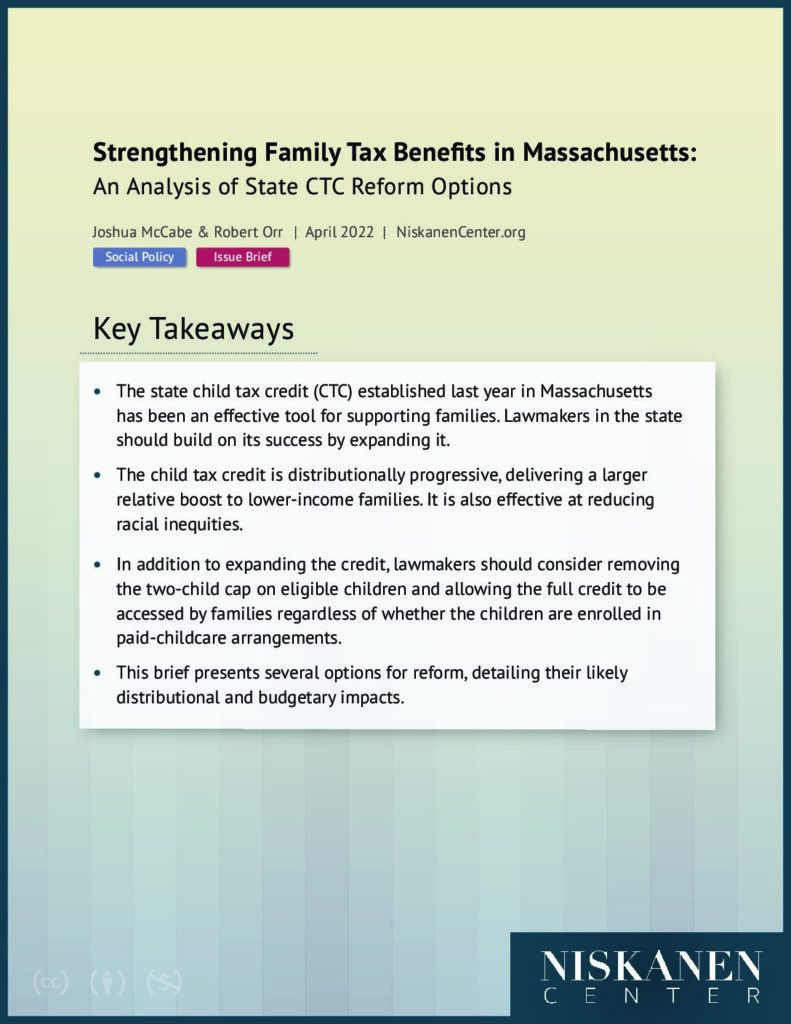Key Takeaways
- The state child tax credit (CTC) established last year in Massachusetts has been an effective tool for supporting families. Lawmakers in the state should build on its success by expanding it.
- The child tax credit is distributionally progressive, delivering a larger relative boost to lower-income families. It is also effective at reducing racial inequities.
- In addition to expanding the credit, lawmakers should consider removing the 2-child cap on eligible children and allowing the full credit to be accessed by families regardless of whether the children are enrolled in paid-childcare arrangements.
- This brief presents several options for reform, detailing their likely distributional and budgetary impacts.
Introduction
In 2021, Massachusetts quietly converted two existing deductions for dependents into a pair of fully refundable child tax credits (CTC) as part of its annual budget. Last month, Governor Charlie Baker proposed doubling these tax credits as part of the fiscal year 2023 budget. This policy brief describes the proposed credits’ anti-poverty, pro-work, and pro-marriage aspects. It also identifies two ways these credits penalize families, including larger families and families not paying for center-based child care. Finally, we offer several options for further improvements.
Background
Historically, Massachusetts families have been eligible for three primary tax benefits that help with the cost of raising children: a $1,000 deduction for each dependent child as well as two tax benefits aimed at families with younger children. The first was a $3,600 deduction for dependents under 12 years old. The second was a $4,200 deduction for work-related child care expenses for children under 13 years old. Both deductions capped the number of eligible children at two per family. Families could claim either deduction – but not both – for each eligible dependent in any given year.
As deductions, one major limitation of both tax benefits is that families needed to earn a certain amount of income to qualify for a partial or full benefit. For example, a family earning $10,800 per year or less would have been excluded from the benefits of these deductions altogether. Because other exemptions and deductions would wipe out any state income tax liability such low-income families had at tax time, the additional deduction was effectively worthless.
In contrast, fully refundable tax credits allow families to receive the full benefit of the credits regardless of income tax liability. Refundable child tax credits have been common in other wealthy democracies for decades, but they were absent in the United States until Congress temporarily enacted one as part of the American Rescue Plan of 2021. Its success and subsequent expiration this year has left many states exploring the possibility of enacting their own state-level refundable child tax credits. Massachusetts became a leader in this effort when the legislature passed and the governor signed the 2021 budget. This converted the existing deductions for dependents under 12 and for work-related child care expenses into a pair of fully refundable tax credits – renamed the Household Dependent Tax Credit (HDTC) and the Dependent Care Tax Credit (DCTC), respectively. These credits keep several characteristics of the deductions they replaced, including eligibility requirements and a family cap limiting them to two children each, but effectively made each credit universal so that all families receive them regardless of income.
Photo Credit: iStock
